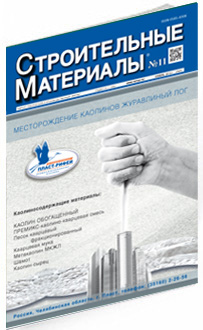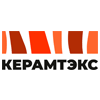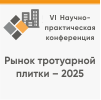Stroitel`nye Materialy №11

November, 2013
Table of contents
G.I. GRINFELD, Executive Director, National Association of Autoclaved Gas Concrete Manufacturers (St. Petersburg)
Preconditions for development and main provisions of STO NAAG 3.1-2013 “Autoclaved concrete in construction of building and structures within the territory of the Russian Federation” and the first version of STO NOSTROY 2.121-2013 “Building constructions of buildings and structures. Arrangement of structures with application of products and reinforced elements from cellular concretes of autoclave hardening. Rules, monitoring of implementation and requirements for the results of the work, recommendations on application”.
Yu.S. VYTCHIKOV, Candidate of Technical Sciences, the Samara State University of Architecture and Civil Engineering; V.M. GORIN, Candidate of Technical Sciences, NIIKeramzit, M.V. GORIN, General Director, OOO PSK “Atlant” (Samara); I.G. BELYAKOV, engineer, the Samara State University of Architecture and Civil Engineering
Results of the theoretical and experimental study of thermal protection characteristics of wall stones made of no-sand haydite concrete are presented. The calculated values of the reduced resistance to heat transfer of the masonry made of wall stones with cement-sand mortar and mortar with reduced heat conductivity have been obtained with the help of the method developed by the article’s authors. The calculation of three-dimensional temperature fields in the external wall fragment was made by the method of finite elements realized in the software package ANSYS.
Experimental data on the value of reduced resistance to heat transfer of the masonry made of haydite concrete stones manufactured by OOO PSK “Atlant” confirm the calculation results.
Key words: thermal protection, resistance to heat transfer, haydite concrete, external wall, power saving.
M.E. SAPAREV, engineer, Yu.S. VYTCHIKOV, Candidate of Technical Sciences, the Samara State University of Architecture and Civil Engineering
The necessity to improve heat protection properties of an external wall made of haydite concrete stones with the help of screen heat insulation which should be a packet (the whole set) of materials with low absorbing capacity and high reflectivity of screens and with air, unventilated interlayers between them is substantiated. Thermo-technical calculation of such structure and also the nomogram for selection of the thickness of the closed air interlayer are presented.
Key words: haydite concrete, enclosing structure, screen heat insulation, air interlayer, thermal resistance, heat flow, temperature fields.
A.V. GRINEVICH, A.A. KISELEV, E.M. KUZNETSOV, Candidates of Technical Sciences, the Research Institute for Fertilizers and Insectofungicides named after Ya.V. Samoylov (Moscow); A.F. BURIANOV, Doctor of Technical Sciences, the Moscow State University of Civil Engineering
Production of Synthetic Anhydrite Calcium Sulfate from Concentrated Sulfuric Acid and Flour Limestone
The complex of studies has been conducted at the model laboratory unit of continuous operation; technology of utilization of waste concentrated sulfuric acid of pyrometallurgical productions by means of its processing with natural flour limestone and obtaining of synthetic anhydrite calcium sulfate has been developed.
Optimal conditions for crystallization of anhydrite sulfate have been determined: temperature – 80-100 °C, content of solids in the pulp – 25-40% and H2SO4 in the liquid phase of pulp – 25-50%, holding time – 1-1.5 hr. Separation of the pulp with water flushing of anhydrite sediment is executed at wet vacuum filters; washing solution of H2SO4 is recirculated for the stage of decomposition of limestone for maintenance of the preset content of solid particles in the pulp. The obtained anhydrite, after washing, drying, introduction of modifying agents and grinding, is a qualitative anhydrite binder which can be used for replacement of traditional anhydrite from natural raw material and preparation of stowing mixes for stowing of abandoned spaces of mines.
Key words: anhydrite calcium sulphate, utilization of sulfuric acid, gypsum binders, stowing mixes.
Kh.A. KHEZHEV, engineer, Yu.V. PUKHARENKO, Doctor of Technical Sciences, the St. Petersburg State University of Architecture and Civil Engineering, T.A. KHEZHEV, Doctor of Technical Sciences, the Kabardino-Balkarian State University named after H. M. Berbekov (Nalchik)
A raw mix for production of the fibrous gypsum tuff concrete composite on the basis of waste of tuff sawing is offered. New formations were established in the gypsum lime tuff concrete composite. Compositions of fireproof fibrous gypsum vermiculite tuff concrete composite have been developed.
Key words: gypsum, tuff sand, caustic lime, blown-out vermiculite, basalt fiber, fibrous gypsum concrete composite.
M.I. KUZMENKOV, Doctor of Technical Sciences, the Belarusian State Technological University (Minsk); S.I. MASYUK, Director, A.M. GRECHNY, Chief Engineer, A.M. KOZEL, Chief Technologist, OAO “Domanovsky PTK” (the Brest Oblast, the Republic of Belarus)
Technology of production of hydrated silicate powders of alkaline metals has been developed. The product is a white powder characterized by the following signs: content (mass %) - SiO2 – 58.7; Na2O(K2O) – 21.2; Н2О – 5.6; silicate module – 2.86; size of particles – 0.1-1 mm; apparent density – 0.7; time of dissolution at 20 °C – during 6 min. The industrial production was organized at OAO “Domanovsky PTK” (the Brest Oblast) with theparticipation of Slovak firm “Lukro”. Annual output of the shop – 1.65 ths tn.
Key words: liquid glass, hydrated silicate powder, spray dryer.
L.A. VAYSBERG, Doctor of Technical Sciences, Corresponding Member of RAS, Research Supervisor, Chairman of Board of Directors, “Mechanobr-Tekhnika” Research and Engineering Corporation (St. Petersburg); E.E. KAMENEVA, Candidate of Technical Sciences, Head of the Test Center of Building Rocks, V.N. AMINOV, Doctor of Technical Sciences, the Petrozavodsk State University (The Republic of Karelia)
Results of the study of physical-mechanical properties of main types of building rocks are presented. Stability of the quality of gabbro-diabase crushed stone is shown. It is substantiated that the crushing scheme of these rocks should be aimed only at improving the cubicity. Strength characteristics and shapes of broken granite grains are less kept, it is connected with a textural and structural features of the initial rocks, used equipment and technology of crushing. Presence of minerals of different strength in some varieties of granite leads to the selective disintegration and creates the opportunity for enrichment of gravel on the strength.
S.V. FEDOSOV, Doctor of Technical Sciences, the Ivanovo State Polytechnic University; B.A. KRYLOV, Doctor of Technical Sciences, OAO “NIC Stroytelstvo” (Moscow); V.I. BOBYLEV, Doctor of Technical Sciences, OOO “DSK Invest+”; A.G. PYZHIKOV, General Director, N.V. KRASNOSELSKIKH, First Deputy General Director, OAO “DSK” (Ivanovo); A.M. SOKOLOV, Doctor of Technical Sciences, the Ivanovo State Power Engineering University
Results of the experimental and theoretical studies of ultimate strength of concrete under compression, temperature and electric characteristics as well as the energy datum of electro-thermal treatment of concrete with currents of higher frequency under the laboratory and production conditions are presented. Data obtained show high efficiency of such method of heat treatment comparing with water vapor treatment: for example, high uniformity of a temperature field is ensured in the volume of products, cost of energy consumed reduces by 5.5-6 times. The actuality of the fastest introduction of such electro-thermal treatment in the manufacture of concrete products at polygon plants where TVO has the worst energy and cost parameters is proved.
V.N. SOKOV, Doctor of Technical Sciences, A.E. BEGLYAROV, Candidate of Technical Sciences, the Moscow State University of Civil Engineering
The energy efficient and express technology of production of three-layer monolithic products with developed specific surface and nano-structured transition zone generated by the hydro-thermal-power field between layers has been developed.
Key words: three-layer product, electric curing, hydro-thermal-power field, nano-structured zone, monolithic-laminated product.
O.G. VOLOKITIN, Candidate of Technical Sciences, N.K. SKRIPNIKOVA, G.G. VOLOKITIN, Doctor of Technical Sciences, V.V. SHEKHOVTSOV, student, the Tomsk State University of Architecture and Building; V.I. VERESHCHAGIN, Doctor of Technical Sciences, the National Research Tomsk Polytechnic University; A.I. KHAYSUNDINOV, Master, the L.N.Gumilyov Eurasian National University (Kazakhstan)
The technology of utilization of products of coal and combustible shales burning in the course of production of mineral fibers with the use of the electro-plasma unit for melting silicate-containing materials is presented. The study of the electro-plasma unit, raw materials and mineral fibers produced on their base has been conducted.
Key words: mineral fibers, waste utilization, electro-plasma unit, silicate melt
A.A. STENIN, engineer (01_ac@bk.ru), A.M. AYZENSHTADT, Doctor of Chemical Sciences, A.A. SHINKARUK, T.A. MAKHOVA, Candidates of Chemical Sciences, the Northern (Arctic) Federal University named after M.V. Lomonosov (Arkhangelsk)
The method of modification of surface of timber with a micro-disperse filler of basalt- saponite-calcium oxide composition is considered. Description of the laboratory unit and technological parameters of the treatment process is presented. With the help of electronic microscopy it is shown that the mineral filler is adsorbed inside the timber pores into the deep of 300-400 mkm and covers the surface with a thin homogeneous layer. This treatment makes it possible to improve fireproof properties of wood and reduce the water absorption.
Key words: micro-disperse filler, basalt, saponite, fireproof properties, water absorption, heat conductivity.
I.M. BARANOV, Candidate of Technical Sciences, R.K. YUSUPOV, Candidate of Chemical Sciences, A.S. TARASOV, Candidate of Technical Sciences, N.I. SOLDATOVA, engineer, OOO “NTC EMIT” (Moscow)
Results of the research in the development of compositions of especially strength fine graded heavy concrete and heavy concrete with a coarse aggregate are presented. Their building-technical properties are described.
Key words: especially strength concrete, micro-silica, strength improvement, modification
A.A. KIRSANOVA, engineer, L.Ya. KRAMAR, Doctor of Technical Sciences, the South Ural State University (Chelyabinsk))
Organomineral Modifiers on the Basis of Meta-Kaolin for Cement Concretes
Prospective methods of improvement of energy and material saving in construction with the use of additive-modifiers of the structure and properties of cement stone and concrete on the basis of meta-kaolin of U-ZhL, UM-ZhL, UMD-ZhL brands are considered. It is proved that the use of these organomineral additives makes it possible to produce concretes of fast hardening under normal conditions with a high durability factor. Concretes with the use of these additives can be used in the construction of roads, hydraulic structure and other important building structures.
Key words: cement concretes, additive-modifiers, meta-kaolin, micro-silica, accelerators of hydration and hardening, corrosion resistance
I.Ya. GNIP, S.I. VAYTKUS, Candidates of Technical Sciences, the Vilnius Gediminas Technical University (Lithuania)
Results of the study of the creep of mineral wool boards under the permanent load which are used for heat insulation of combined coverings, wall facades, monolithic floors and external walls of cellars as well as for sound insulation of floors of buildings are presented. The creep study was conducted at compressive stress which was 35% of slab strength for compression at 10% deformation. For anticipation of 10 years the interval forecasting of deformation creep was made by the method of creep process extrapolation, approximated with the exponential equation and taking a logarithm reduced to the linear form. For the direct experiment conducted in accordance with recommendations of GOST R EN 1606 concerning the time moment for deformation measurement and approximation of the creep process on the base of the exponential model, the regression equation for determination of 90% of upper and lower levels of confidence limits of creep deformation for anticipation of T= 0.5-10 years using the mean square deviation of logarithmic real observations of creep deformations from the linear trend at retrospective section is presented.
Key words: mineral wool boards, long time compression, phenomenological description of creep, exponential model, interval prediction.
V.A. USHKOV, Candidate of Technical Sciences, D.I. NEVZOROV, engineer (pehel@yandex.ru), L.S. GRIGORIEVA, V.M. LALAYAN, Candidate of Chemical Sciences, the Moscow State University of Civil Engineering
The influence of the content and chemical nature of mineral fillers on combustibility and smoke generation ability of polymer building materials (PBM) is considered. The whole set of experimental data obtained show that the specific quantity of heat absorbed by the filler is a main parameter determining the influence of mineral fillers on combustibility of PBM. The dependence of the oxygen index (OI) of PBM on the specific heat of mineral fillers is revealed.
Key words: combustibility, mineral filler, oxygen index, specific heat, fire hazard, coefficient of smoke generation.
E.V. VOYTOVICH, Candidate of Technical Sciences, N.I. KOZHUKHOVA, engineer(kozhuhovanata@yandex.ru), I.V. ZHERNOVSKY, Candidate of Geological-Mineralogical Sciences, A.V. CHEREVATOVA, Doctor of Technical Sciences, D.D. NETSVET, engineer, the Belgorod State Technological University named after V.G. Shukhov
A concept of quality control which can be a basic platform for development of necessary normative-technical documentation for considered binders of polymerization and polymerization-polycondensation types of hardening is offered.
Key words: aluminum silicate binder, binder of polymerization and polymerization-polycondensation types of hardening.
V.S. LESOVIK, Doctor of Technical Sciences, the Belgorod State Technological University named after V.G. Shukhov; M.A. FROLOVA, Candidate of Chemical Sciences (aizenmaria@gmail.com), A.M. AYZENSHTADT, Doctor of Chemical Sciences, the Northern (Arctic) Federal University named after M.V. Lomonosov (Arkhangelsk)
The aim of the research is the estimation of the surface activity of ultradispersed systems obtained by dispersion of model samples of rocks. The data obtained show that the value of surface activity(ks) can be used as a main criterion of quantitative energy classification of raw materials on the basis of rocks for producing building composites. A model of the experimental definition of parameters necessary for calculating ks is presented in the article.
Key words: rocks, atomization energy, specific mass energy of atomization, value of surface energy, surface activity
 |
 |
 |
 |
 |
 |
